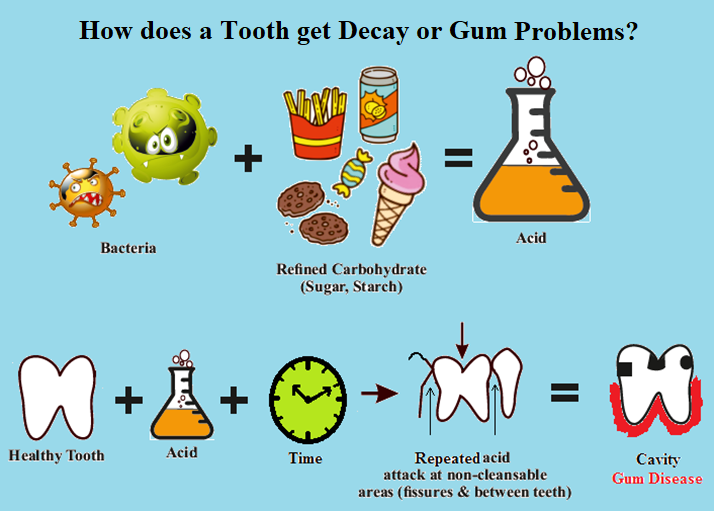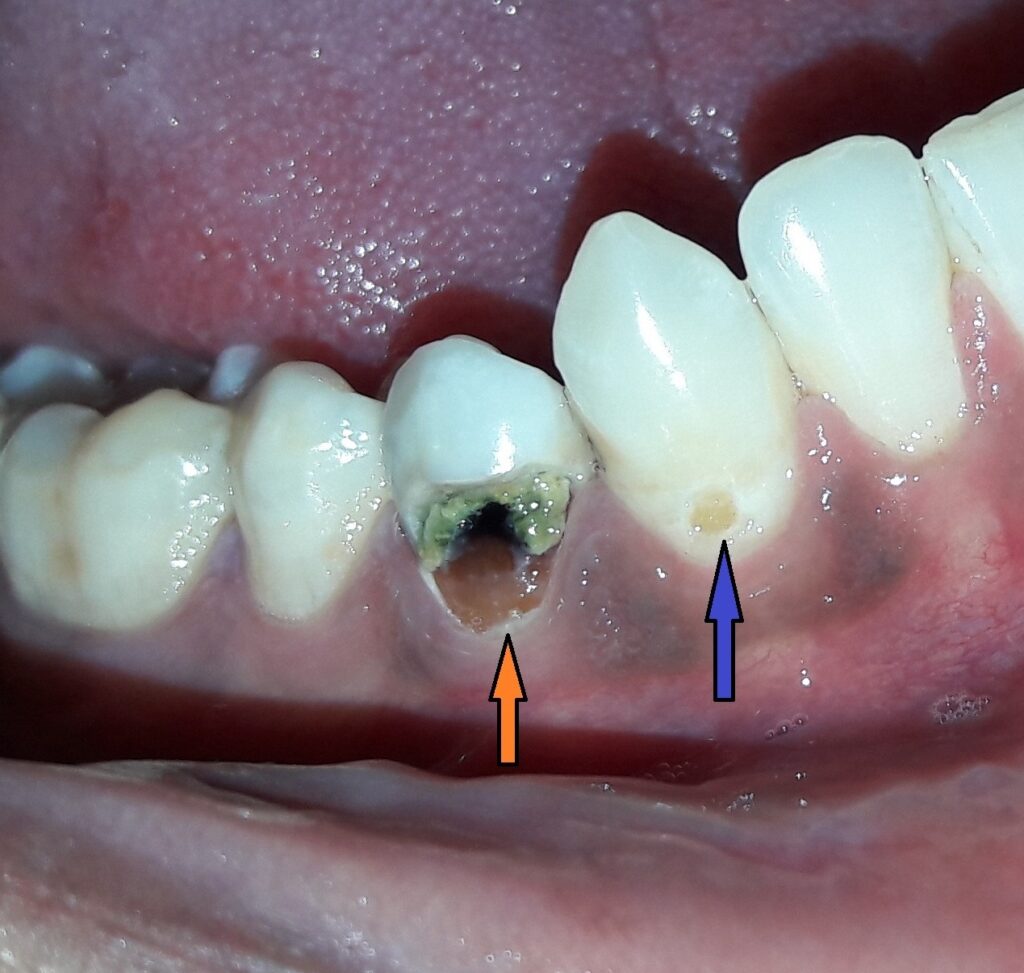
how does tooth decay start?
Tooth decay is one of the most common diseases that affects people of all ages. In this article, we will explore the causes and progression of tooth decay, as well as some tips for preventing and treating this condition.
What is tooth decay or cavity?
Tooth decay is a bacterial infection that causes breakdown of tooth enamel, and other inner structures of the tooth. When bacteria deposits (dental plaque) repeatedly produce acid, it can dissolve the enamel and create small hole or cavity. If left untreated, the cavity can become larger and reach inner layers of the tooth, lead to serious oral health issue, such as pain, infection, and tooth loss.
How does tooth decay start?
Dental plaque, which is the accumulation of bacteria on teeth, is the primary cause of tooth decay. However, other factors such as inadequate oral hygiene practices, consumption of sugary and acidic foods, and insufficient fluoride in water also contribute significantly to the development of tooth decay.
Dental plaque is an invisible, sticky bacterial film that develops on teeth when sugars or starches are not effectively cleaned. Bacteria thrive on these food sources and establish a home within the plaque, where they are protected and nourished. Plaque is continually produced in the mouth, particularly after eating sugary and starchy foods. Carbohydrates such as sugar and starches, are easily broken down by bacteria in plaque, whereas protein, fats and vitamins are less readily broken down. When sugar is broken down, acid is released, which can lead to tooth decay and gum diseases.
Tooth decay occurs only after repeated cycle of fresh plaque formation and acid attack, over a longer period. Cavities do not form overnight, after just a few instances of acid attack.
In the early stages, the enamel of the tooth begins to weaken and small white or yellow spots may appear on the tooth surface. As the decay progresses, the enamel becomes more and more weakened and undermined, eventually leading to the formation of a small cavity. At first, the cavity may not cause any symptoms, but as it grows larger, it can cause pain and sensitivity.

Early and advanced tooth cavities: Early cavity (blue arrow), Advanced cavity (orange arrow)
How does tooth decay progress?
If tooth decay left untreated and if fresh plaque accumulation continues, a cavity can eventually penetrate the inner layers of the tooth, including the pulp, which contains nerves and blood vessels. This can cause severe pain, infection, and even tooth loss. In some cases, the infection can spread to other parts of the body, causing serious health problems.
How to Prevent Tooth Decay?
It is important to remember that once a cavity has formed, it cannot be reversed, and the damaged tooth cannot regenerate or repair itself and only a dentist can restore the tooth. Therefore, it is crucial to adhere strictly to preventive measures to ensure good oral health.
Maintain Good Oral Hygiene
Good oral hygiene, including regular brushing and flossing; removes plaque and can prevents tooth decay.
Brush your teeth at least twice a day, and preferably after every meal. Use a soft-bristled toothbrush and fluoride toothpaste, and brush your teeth for at least two minutes each time. Use circular motions, gentle and short strokes, focusing on cleaning all tooth surfaces, including below the gumline.
Floss your teeth at least once a day, especially after dinner before going to bed. Floss is not a substitute for a toothbrush, but it is equally important. It removes plaque from hard-to-reach areas between the teeth where a toothbrush cannot reach.
A water flosser, also known as oral irrigator, is a handheld device that uses a stream of water to remove food debris and bacteria from between the teeth and below the gumline. It can be particularly helpful for patients with braces or dental appliances because cleaning appliances or braces with regular brushing and flossing alone can be difficult.
It is recommended to gently clean your tongue as part of your routine oral hygiene care. Using a tongue brush or tongue scraper, you can remove any food debris left on your tongue after brushing your teeth. This can help prevent the build-up of plaque on your teeth, which can lead to tooth decay and gum disease. Therefore, cleaning your tongue is an important aspect of maintaining good oral health.
It is recommended to avoid using anti-germ mouthwashes daily, unless advised by your doctor. These mouthwashes should only be used in specific situations and for specific period, such as during acute infections, hospitalization, or postoperative phase. In general, mechanical measures like toothbrushing and flossing have been proven to be more effective in keeping teeth free from plaque than chemical measures like mouthwashes and antibiotics. Mouthwashes can also lead to regular exposure to chemicals, including antibiotics.
Regular dental visit
Visit your dentist regularly for check-up and professional cleaning, at least every six months. The frequency of dental visits should be dependent on your oral health and your dentist’s recommendations.
People who need dental visit more often include:
- People with dry mouth, often caused by medications or aging. Saliva plays a crucial role in protecting the teeth and gums by helping to wash away food particles and bacteria.
- Those who lack the physical dexterity to thoroughly brush their teeth.
- Those who have limitations in their ability to understand or carry out a proper dental hygiene routine.
- Those with crooked or crowded teeth.
- Those who wear braces to correct misaligned teeth.
- Those who have dental appliances, restorations, or bridges.
- Those who have restricted mouth opening.
Eat healthy foods
To promote good oral health, it is important to limit the intake of sugary and starchy foods and drinks, and instead consume a diet rich in nutritious foods, such as fresh vegetables and fruits. These foods are good for oral health because they contain high amounts of fiber which require chewing and help to clean the teeth. Additionally, the act of chewing stimulates the production of saliva, which helps to wash away debris and harmful bacteria that can contribute to the formation of plaque and tooth decay. Additionally, consuming a diet rich in vitamins and minerals found in fruits and vegetables can help strengthen teeth and gums.
Chew your food
Chewing your food thoroughly not only helps in a self-cleansing process, but also kickstart the digestion, paving the way for a healthier and more efficient nutrient absorption.
Drink water
Drink plenty of water daily to rinse your mouth and promote saliva production. Drinking an adequate amount of water can not only promote good oral health, but also improve overall health.
Avoid use of tobacco
While tobacco use may enhance the development of dental plaque, it is also a well-known risk factor for various types of cancer. Read more about how to quit smoking in our article titled ‘Quitting Tobacco: From Smoke to Success – Your Journey to Becoming Healthier, Wealthier, and Famous’.
Self-examination
Periodic self-examination of your teeth and mouth is also crucial to maintain good oral health and detect any potential issues early on.
Other preventive measures
Dental sealants: It seals the natural pits and fissures present on the top chewing surfaces of your teeth, and thus prevent plaque from forming on those surfaces.
Fluoride Treatment: Fluoride is known to effectively slow down the growth of plaque-causing bacteria, while also providing a protective seal over the micro pits and fissures that naturally occur on the teeth.
Dry mouth: If you experience dry mouth, it is important to consult your oral physician for proper diagnosis and treatment. It is advisable to drink ample amount of water and rinse your mouth after each meal in order to promote good oral hygiene and overall health. You may find relief by using over-the-counter available salivary substitutes.
Treatment for crooked or crowded teeth – Can prevent plaque build-up and improve dental health.
Treatment of Tooth Decay
Here are some common treatments for tooth decay:
- Fillings: Tooth decay can be treated with fillings when the cavity is small and has not yet reached the pulp. This involves removing the decayed portion of the tooth and filling the cavity with either amalgam, which is a silver filling, or a tooth-colored material such as composite resin.
- Crowns: When tooth decay has progressed over a large area where a filling would not be able to provide sufficient support, a crown may be necessary. A crown is an artificial cap that is placed over the natural crown, or the top of the tooth, to restore its size, shape, and function.
- Root canal treatment (RCT): When tooth decay has progressed to the point where it has reached the pulp, which contains the blood and nerve supply to the tooth, a root canal treatment (RCT) may be necessary. This involves removing the infected or damaged pulp, cleaning the root canals, and sealing them with a biocompatible material to prevent further infection and restore the functionality of the tooth. RCT is often considered the last hope to save a tooth that would otherwise need to be extracted. After undergoing RCT, it is recommended that the treated tooth be fitted with a crown. This is very important because without a crown, the tooth may become weakened and vulnerable to breakage, which could ultimately lead to the need for extraction.
- Extraction: In cases where a tooth is severely decayed and cannot be saved even with root canal treatment (RCT), or if the tooth is restorable but lacks sufficient gum and bone support, extraction may be necessary. This involves the complete removal of the affected tooth from its socket in the jawbone.
Following a tooth extraction, it is important to restore the empty space with an artificial tooth such as a dental implant, bridge, or denture. Failure to do so can result in an imbalance in the distribution of forces among the remaining teeth, causing them to shift and potentially disturb the occlusion, or the way the teeth come together when biting or chewing.
Conclusion
Tooth decay is a common dental problem that can lead to serious consequences if left untreated. Numerous studies have shown that even with restoration or root canal treatment, teeth or implants may not fully replicate the functionality of a healthy natural tooth. Hence, preventing tooth decay is the most effective approach. Saving your teeth will lead to improved oral health and overall health. Understanding the causes and progression of tooth decay can be beneficial in preventing and identifying it early, ultimately helping to maintain a healthy and attractive smile. However, consistently practicing good oral hygiene habits from an early age and throughout life is crucial.











